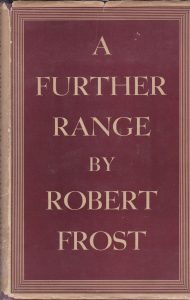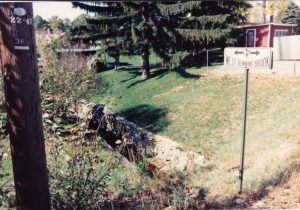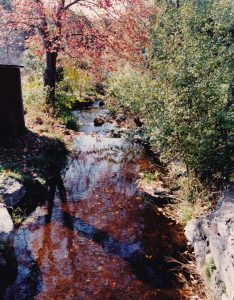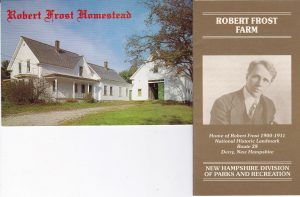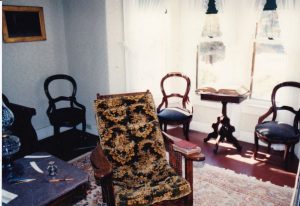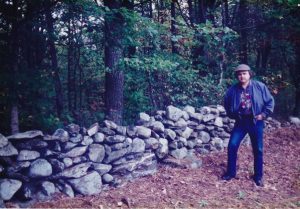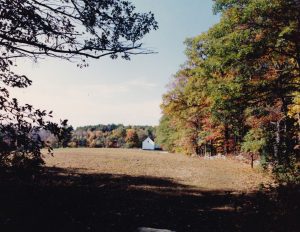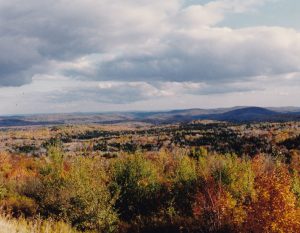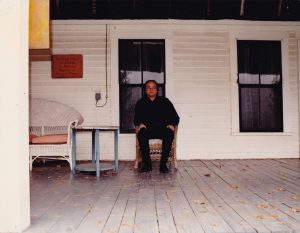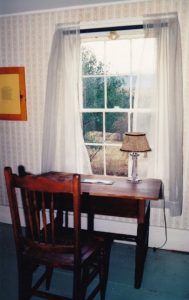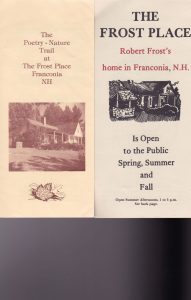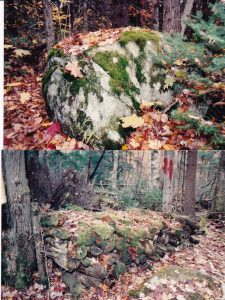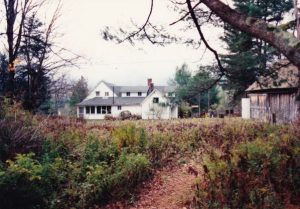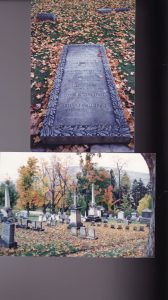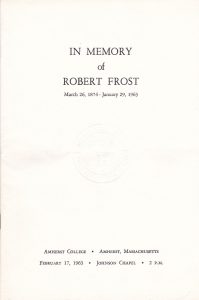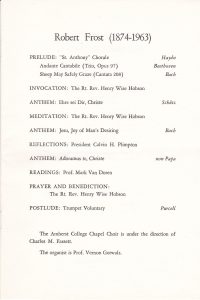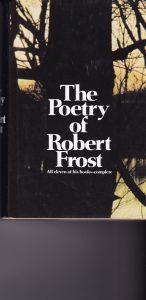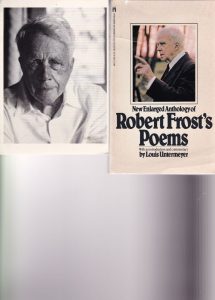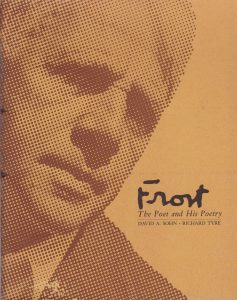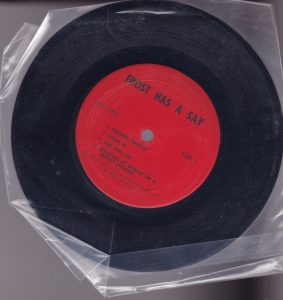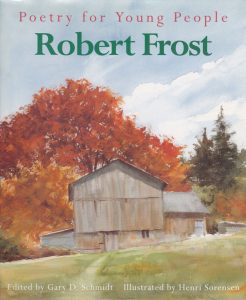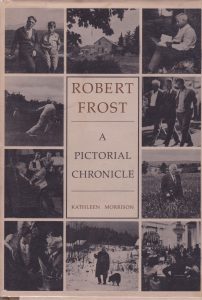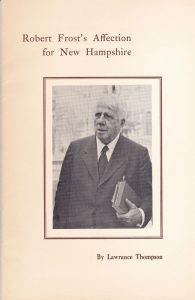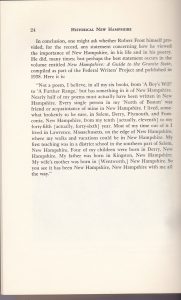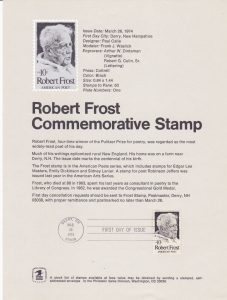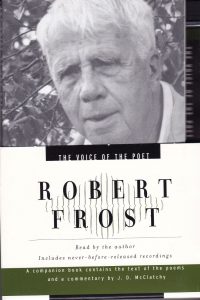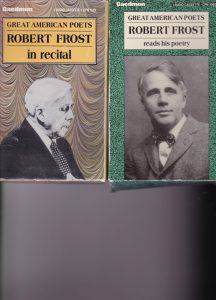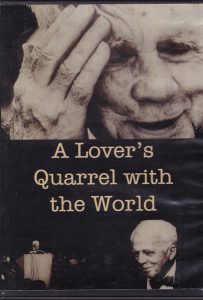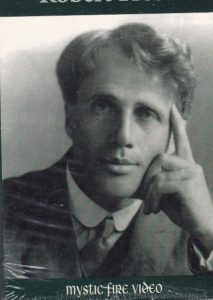A 1936 signed copy.
…………………………………………………………….
The first poet, whose work resonated for me, was Robert Frost in 1966. My artsy grade 11 English teacher read and illustrated two poems (“The Road Not Taken” and “Birches”) by drawing what they would look like on ye olde chalkboard. The other poems we studied then were “Stopping by Woods on a Snowy Evening” and “After Apple-Picking”, classics all. I was also further intrigued by “Once by the Pacific” and “Design”.
I took a Modern American Lit course at U of A and studied “The Tuft of Flowers”, “Death of the Hired Man”, “Acquainted with the Night”, “Desert Places”, “Two Tramps in Mudtime” and “Departmental”. Later, through teaching, I would come to know many more in the Frost canon.
In fall, 1990 and 1994, I made two trips to places where Frost lived in Massachusetts, New Hampshire, and Vermont. I stayed at the Lord Jeffery Inn in Amherst, Mass. where he stayed when he was visiting and presenting or teaching at Amherst College.
Driving into Derry, N.H., you immediately pass West-Running Brook, which was the title of one of his best poems and one of his books (1928).
West-Running Brook in 1990.
The Farm was where he first lived and wrote before he went to England (partially because his wife Elinor wanted to live “under thatch”) and became famous with the publication there of his first two books in 1913 and 1914. He had been given the farm to work by a relative, but was fairly casual about it; he also taught a bit to make ends meet.
Frost’s chair; he used to put a specially-constructed board across it to write on.
“Mending Wall” is one of his famous poems about the custom of New England farmers going out in the spring to reorganize their rock walls separating their properties. 1990: me beside the wall that inspired the poem that led off his second book North of Boston.
You can see the same wall on the right; this picture is taken behind the barn at the end of a field. When the farm fell out of the family’s hands, the field became an auto junkyard, but was later restored to something resembling its original appearance by the state.
Hyla Brook, at the end of the field, takes you into the woods. There is a brochure for the walk. The coin was purchased from the modest store in the barn which has other Frost memorabilia.
Heading north to the top of New Hampshire, you eventually reach The Robert Frost Place near Franconia. These are the White Mountains across the road from the Place.
You drive up to the Place which is where the family first lived when they came back from England with Frost an overnight, suddenly well-known literary success.
1990: I took the liberty of sitting down where the Frosts likely sat down on the porch during the day to look at the White Mountains.
Inside, Frost’s modest desk looks out the back toward the bush.
There is a mountain trail at this attraction, as well, beginning behind the house.
Two ‘stations’ on the walk. The lower recalls his woodpile poem.
What you see of the back of the house from the start of the walk.
Alone, after Elinor’s death and the tragic suicide of his son Carol, Frost sought refuge and escape in a cabin in Ripton, Vermont. Kathleen Morrison, a professor’s wife, living on an adjacent property, got involved in his life, looking after his meals and his business affairs. It’s been suggested that “The Silken Tent” was written for her. In the photos above, the graveyard and family grave of the Frost family in Bennington, Vt.
I came across the program for Frost’s funeral in Amherst. Prof. Mark Van Doren read (in order) the following poems: “Revelation”, “Neither Out Far Nor in Deep”, “The Secret Sits”, “To Earthward”, and “The Telephone”, “The Silken Tent”, “Nothing Gold Can Stay”, “Acceptance”, “I Could Give All to Time”, from “The Lesson for Today”, and “Away!”
The book on the left has all the Frost poems. I used the illustrated Untermeyer paperback book with my senior-high English classes in the ’70s and ’80s.
His publisher put out a nice volume with photos which included a vinyl record of the poet reading 8 of his works.
This is a nice book introducing younger kids to his poetry.
This book picks up Frost’s story after the two aforementioned family deaths. It is amply illustrated and gives many insights into Frost’s character and beliefs by the woman who knew him well/best in his later life.
An example of how New Hampshire tried to have the last say on whether Frost was a Vermont or New Hampshire poet. I should mention, too, that Ripton and Bread Loaf College were close to each other and Frost taught at the latter in many summers.
One of many awards and commemorations. He won the Pulitzer Prize 4 times.
This is the definitive CD reading of his poems with a handy book to follow along. The poems read are listed; some famous ones are not here including “West-Running Brook”, “Once by the Pacific”, “Acceptance”, “A Considerable Speck”, and “Death of the Hired Man” found on other LPs and cassettes.
Caedmon led the way in recording Frost. There is also a good LP of Frost talking and reading to a select group of Yale students, kidding along with them. He had a good sense of humor and joked about some of his poems to get a rise out of his audience. He was quite the performer in close company.
This is the 1963 film which won an Academy Award for documentaries. It has recently been re-released at long last on DVD.
The 1988 video which has many readings, biographical information, and critical response. It presents the darker side of the poet’s soul well.
Robert Frost has long been a key part of my literary sensibility. He influenced me with his depictions of Nature, his use of imagery, rhythm, rhyme, and colloquial language, his wide range of topics and themes, and was the first poet to truly speak to me. I have learned much from his work and still consider him America’s top nature poet.
A little fuzzy, but shows a compass gift I received with “The Road Not Taken” quoted in full.

